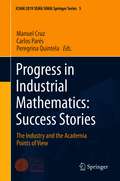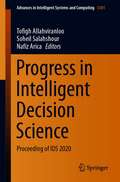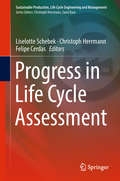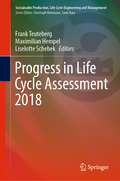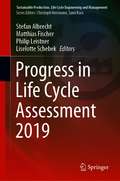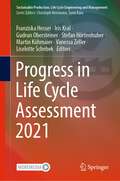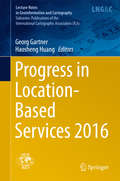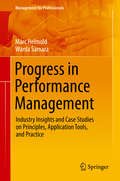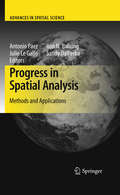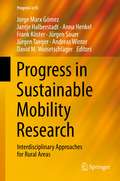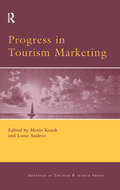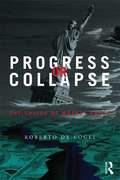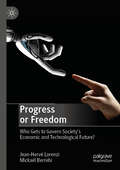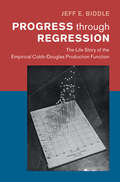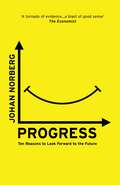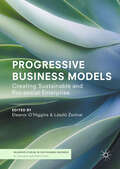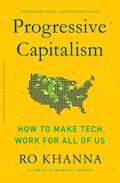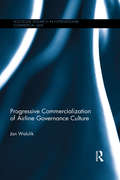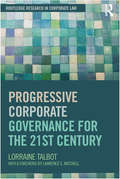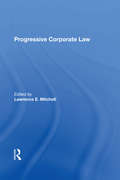- Table View
- List View
Progress in Industrial Geography (Routledge Revivals)
by Michael PacioneThis edited collection, first published in 1985, deals with a number of the major themes central to the study of industrial geography. Topics under discussion include new methodologies, the growing service industries, foreign investment and the industrial geography of the developing world. With a detailed introduction from Michael Pacione and comprehensive coverage, the title reflects the extent to which the field of industrial geography changed over the second half of the twentieth century in response to economic change, incorporating the growth of multinational enterprises and the influence of globalisation, alongside traditional discussion of the manufacturing industry. Providing an essential background to developments in industrial geography, this title will be valuable to students with an interest in the economics, characteristics and advancement of industrial change.
Progress in Industrial Mathematics: The Industry and the Academia Points of View (SEMA SIMAI Springer Series #5)
by Manuel Cruz Peregrina Quintela Carlos ParésThis book presents a panorama about the recent progress of industrial mathematics from the point of view of both industrials and researchers. The chapters correspond to a selection of the contributions presented in the "Industry Day" and in the Minisymposium "EU - MATHS - IN: Success Stories of Applications of Mathematics to Industry" organized in the framework of the International Conference ICIAM 2019 held in Valencia (Spain) on July 15-19, 2019. In the Industry Day, included for the first time in this series of Conferences, representatives of companies from different countries and several sectors presented their view about the benefits regarding the usage of mathematical tools and/or collaboration with mathematicians. The contributions of this special session were addressed to industry people. Minisymposium contributions detailed some collaborations between mathematicians and industrials that led to real benefits in several European companies. All the speakers were affiliated in some of the European National Networks that constitute the European Service Network of Mathematics for Industry and Innovation (EU-MATHS-IN).
Progress in Intelligent Decision Science: Proceeding of IDS 2020 (Advances in Intelligent Systems and Computing #1301)
by Tofigh Allahviranloo Soheil Salahshour Nafiz AricaThis book contains the topics of artificial intelligence and deep learning that do have much application in real-life problems. The concept of uncertainty has long been used in applied science, especially decision making and a logical decision must be made in the field of uncertainty or in the real-life environment that is formed and combined with vague concepts and data. The chapters of this book are connected to the new concepts and aspects of decision making with uncertainty. Besides, other chapters are involved with the concept of data mining and decision making under uncertain computations.
Progress in Life Cycle Assessment (Sustainable Production, Life Cycle Engineering and Management)
by Christoph Herrmann Liselotte Schebek Felipe CerdasThe book contains the latest developments in the field of life cycle assessment (LCA) and its application. It contains numerous research articles from leading German research institutes working towards the further development of the methodology. The book provides important insights for professionals working in the field of sustainability assessment, for researchers interested in the current state of the research of the methodology and its application as well as for advanced university students in different science and engineering fields.
Progress in Life Cycle Assessment 2018 (Sustainable Production, Life Cycle Engineering and Management)
by Maximilian Hempel Liselotte Schebek Frank TeutebergThis book comprises recent developments in life cycle assessment (LCA) both with regards to the methodology and its application in various research fields, including mobility, engineering and manufacturing. Containing numerous original research articles from leading German research institutes, the book provides an insightful resource for professionals working in the field of sustainability assessment, for researchers interested in the current state of LCA research as well as for advanced university students in different scientific and engineering fields.
Progress in Life Cycle Assessment 2019 (Sustainable Production, Life Cycle Engineering and Management)
by Liselotte Schebek Matthias Fischer Stefan Albrecht Philip LeistnerThis book covers the latest developments in life cycle assessment LCA both in terms of methodology and its application in various research areas. It includes methodological questions as well as case studies concerning energy and mobility, materials and engineering, sustainable construction and future technologies. With numerous research articles from leading German and Austrian research institutes, the book is a valuable source for professionals working in the field of sustainability assessment, researchers interested in the current state of LCA research, and advanced university students in various scientific and technical fields.Chapter “Life Cycle Assessment of a Hydrogen and Fuel Cell RoPax Ferry Prototype” is available open access under a Creative Commons Attribution 4.0 International License via link.springer.com.
Progress in Life Cycle Assessment 2021 (Sustainable Production, Life Cycle Engineering and Management)
by Liselotte Schebek Franziska Hesser Iris Kral Gudrun Obersteiner Stefan Hörtenhuber Martin Kühmaier Vanessa ZellerThis book covers the latest developments in life cycle assessment (LCA) both in terms of methodology and its application in various research areas. It includes methodological questions as well as case studies of strategies in the context of circular economy and new emerging technologies, design of conceptual frameworks, especially related to social LCA, and the use of novel modeling approaches with a focus on energy supply and land use. With research articles from leading German and Austrian research institutes, the book is a valuable source for professionals working in the field of sustainability assessment, researchers interested in the current state of LCA research, and advanced university students in various scientific and technical fields. 6 chapters are available open access under a Creative Commons Attribution 4.0 International License via link.springer.com.
Progress in Location-Based Services 2016 (Lecture Notes in Geoinformation and Cartography)
by Georg Gartner and Haosheng HuangThis book offers a selection of the best papers presented at the 13th International Symposium on Location Based Services (LBS 2016), which was held in Vienna (Austria) from November 14 to 16, 2016. It provides an overview of recent research in the field, including the latest advances in outdoor/indoor positioning, smart environment, spatial modeling, personalization and context awareness, cartographic communication, novel user interfaces, crowd sourcing, social media, big data analysis, usability and privacy.
Progress in Performance Management: Industry Insights and Case Studies on Principles, Application Tools, and Practice (Management for Professionals)
by Marc Helmold Warda SamaraThis book provides a holistic and pragmatic approach to performance management throughout the business value chain, and demonstrates the optimal design and use of performance management in order to achieve competitive advantage. A wealth of best practices, case studies and real-world examples are used to reveal the diversity of performance measurement methods, methodologies and principles in practice. Readers will gain comprehensive insights into the status quo of performance management, including primary functions such as supply, operations and sales, and secondary functions like finance, human resources, and information systems. Focusing on ‘best-in-class’ performance excellence, the book offers the ideal guide for any organization pursuing competitive advantages across all corporate functions and focusing on value-adding activities.
Progress in Spatial Analysis
by Antonio Páez Julie Gallo Ron N. Buliung Sandy Dall'ErbaSpace is increasingly recognized as a legitimate factor that influences many processes and conceptual frameworks, including notions of spatial coherence and spatial heterogeneity that have been demonstrated to provide substance to both theory and explanation. The potential and relevance of spatial analysis is increasingly understood by an expanding sphere of cogent disciplines that have adopted the tools of spatial analysis. This book brings together major new developments in spatial analysis techniques, including spatial statistics, econometrics, and spatial visualization, and applications to fields such as regional studies, transportation and land use, political and economic geography, population and health. Establishing connections to existing and emerging lines of research, the book also serves as a survey of the field of spatial analysis and its links with related areas.
Progress in Sustainable Aviation (Sustainable Aviation)
by T. Hikmet Karakoc Can Ozgur Colpan Alper DalkiranProgress in Sustainable Aviation looks at recent progress and new technological developments in sustainable aviation, presenting readers with engineering solutions and methodologies for efficiency and cost savings, performance improvement, and emission reduction. Coverage includes alternative fuel types, propulsion technologies, and emission technologies used in different aerial vehicles, such as unmanned aerial vehicles, drones, and passenger aircraft. Operational areas, such as the building of green airports, commercial air transport, and maintenance management are also addressed. This collection will be a valuable reference for researchers, practicing engineers, scientists, and students working in the area of sustainable aviation technology and management. Looks at recent progress in sustainable aviation technologies;Presents alternative aviation fuel types and propulsion technologies;Includes case studies and practical applications.
Progress in Sustainable Mobility Research: Interdisciplinary Approaches for Rural Areas (Progress in IS)
by Andreas Winter Jorge Marx Gómez Jantje Halberstadt Jürgen Sauer Anna Henkel Frank Köster Jürgen Taeger David M. WoisetschlägerThis book presents the outcomes of the trans- and interdisciplinary research project NEMo (Nachhaltige Erfüllung von Mobilitätsbedürfnissen im ländlichen Raum - Sustainable Fulfilment of Mobility Needs in Rural Areas). Due to demographic change, it is becoming increasingly difficult for rural districts and communities to maintain a basic set of public transport services such as bus and train transit without encountering issues regarding necessary social participation, sensible regional value creation and, last but not least, achievable environmental protection goals. At the same time, the demand for mobility in rural areas will continue to rise in the future, e.g. due to the concentration of medical care facilities and shopping centres close to cities. Focusing on the development of sustainable and innovative mobility services and business models, this book explains how new mobility offers can be created in which citizens themselves become mobility providers. To do so, it combines the findings of the individual research groups with external contributions from science and practice.
Progress in Tourism Marketing (Routledge Advances In Tourism Ser.)
by Elsevier LtdThe aim of this book are two-fold: (1) to evaluate the current progress of theoretical approaches to tourism marketing and (2) to show the ways to further develop the concept of tourism marketing for application within tourist destinations and individual businesses and evaluate its potential impact on performance improvement. The structure is based upon the inclusion of an introduction and four main parts, namely IT marketing, destination competitiveness, image measurement, and consumer behaviour. There is a brief introduction for each part prior to the discussion of specific chapters just to make the readers familiar with their content. The editors believe that there is a need for information on how to better apply both traditional and contemporary marketing tools in order to be more competitive within the international arena.Metin Kozak serves as an Associate Professor of Marketing in the School of Tourism and Hotel Management, Mugla University, Turkey. Also, he is a visiting fellow in the Department of Marketing, University of Namur, Belgium. Following a successful career within the last five years (since the approval of PhD degree in 2000), Metin has received two awards to mark his achievements. In 2001, his PhD dissertation on benchmarking was nominated, by the EFQM- EU, among the best three PhD studies on TQM. In 2004, by a committee of the Turkish Tourism Investors’ Association, he was awarded the grand prize of the tourism researcher of the year 2003 in Turkey. He has published mainly in tourism journals and authored a book on Destination Benchmarking. His main research interests focus on consumer behavior, benchmarking, competitiveness, cross-cultural research, destination management and marketing, and European tourist markets. Luisa Andreu is Assistant Professor of Marketing in the Department of Marketing, University of Valencia, Spain. She obtained her Master's degree in Tourism from the International Centre for Tourism, Bournemouth University, UK, and a Ph.D. in Business Administration from the University of Valencia, Spain. She is a member of the Spanish Association of Scientifics in Tourism. She has published various articles in Annals of Tourism Research, Tourism Management, European Journal of Marketing, Journal of Travel and Tourism Marketing, among others. She has presented papers at several conferences organized by the European Marketing Academy, Academy of Marketing Science, CPTHL, and State of the Art: Tourism. She has also involved in numerous academic and industrial projects. Her research interests include consumer behavior and cross-cultural issues in service marketing.
Progress or Collapse: The Crises of Market Greed
by Roberto De VogliHuman progress is heading toward collapse. There are converging ecological crises looming on the horizon: climate change, peak oil, water shortages, fish depletion and food scarcities. The world is on a collision course against the limits of the ecosystem. Modern societies are consuming, polluting and growing as if there is no tomorrow. Indeed, there may not be one. In Progress or Collapse, Roberto De Vogli guides us through the multiple converging global crises of economic progress. He explores the connections between the environmental crisis and the psychological, social, cultural, political and economic emergencies affecting modern societies. It is not a coincidence, the author argues, that global ecological destruction is occurring in tandem with other crises: rising mental disorders, mindless consumerism, rampant conformism, status competition, civic disengagement, startling social inequalities, global financial instability, and widespread political impasse. In this hard-hitting analysis, Roberto De Vogli identifies the root cause of all these symptoms of societal breakdown: neoliberalism, defined as market greed. He argues that in recent decades, modern societies have been dominated by a suicidal economic doctrine based on two articles of faith: the greed creed and the market God. The greed creed states that people are nothing but selfish profiteers in a perpetual search for status and wealth. The market God is the belief that all societal and human affairs are best regulated as market exchanges. What is to be done? Can we stop progress toward collapse? Given the current distribution of power and wealth, and the state of psychological and political inertia in which we are trapped, our chances of redefining progress around alternative values and embracing a new philosophy of life are slim. Yet, the history of human emancipation has often been shaped by giant leaps forward. In the past, civic struggles have overcome "the limits of the possible". Whether this will happen again in the future is the central question of our time. This book will be of interest to researchers and students of ecology, psychology, public health, epidemiology, human development, political philosophy, economics, sociology and politics.
Progress or Freedom: Who Gets to Govern Society’s Economic and Technological Future?
by Jean-Hervé Lorenzi Mickaël BerrebiTechnological dominance is shifting the balance of global economic stability. This is the central premise behind the latest book from Lorenzi and Berrebi who view the rise of artificial intelligence, robotics, use of private data, and genetic transformation, among other developments, culminating in new economic conditions that require a fresh sense of governance in order for society to sustain order. Whilst progress in technology provides numerous opportunities and hope, is the desire to pursue these ambitions in innovation putting our society at risk of being undermined and, ultimately, governed by technology firms? How will these changes affect economic outlooks in an age of growing inequality and aging populations? What role do politicians serve in facilitating these changes? The decline of a labour force, the use of Big Data and increased speeds of communication are but three examples that the authors address in their quest to understand where the limits should lie between progress and disruption for the future of society.
Progress through Regression: The Life Story of the Empirical Cobb-Douglas Production Function (Historical Perspectives on Modern Economics)
by Jeff E. BiddleThe Cobb-Douglas regression, a statistical technique developed to estimate what economists called a 'production function', was introduced in the late 1920s. For several years, only economist Paul Douglas and a few collaborators used the technique, while vigorously defending it against numerous critics. By the 1950s, however, several economists beyond Douglas's circle were using the technique, and by the 1970s, Douglas's regression, and more sophisticated procedures inspired by it, had become standard parts of the empirical economist's toolkit. This volume is the story of the Cobb-Douglas regression from its introduction to its acceptance as general-purpose research tool. The story intersects with the histories of several important empirical research programs in twentieth century economics, and vividly portrays the challenges of empirical economic research during that era. Fundamentally, this work represents a case study of how a controversial, innovative research tool comes to be widely accepted by a community of scholars.
Progress, Poverty and Population: Re-reading Condorcet, Godwin and Malthus
by John AveryThis work traces the history of a debate which took place among the economists, political philosophers and writers of the late 18th and early 19th centuries, about whether the benefits of scientific progress would be nullified by the growth of the global population.
Progress: Ten Reasons to Look Forward to the Future
by Johan NorbergA Book of the Year for The Economist and the Observer Our world seems to be collapsing. The daily news cycle reports the deterioration: divisive politics across the Western world, racism, poverty, war, inequality, hunger. While politicians, journalists and activists from all sides talk about the damage done, Johan Norberg offers an illuminating and heartening analysis of just how far we have come in tackling the greatest problems facing humanity. In the face of fear-mongering, darkness and division, the facts are unequivocal: the golden age is now.
Progressive Business Models: Creating Sustainable and Pro-Social Enterprise (Palgrave Studies in Sustainable Business In Association with Future Earth)
by László Zsolnai Eleanor O'HigginsThis book presents and analyses exemplary cases of progressive business, understood as ecologically sustainable, future-respecting and pro-social enterprise. The authors present a number of companies following progressive business practices from a range of industries including ethical and sustainable banking, artisan coffee production and distribution, pharmaceutical products, clean technology, governance in retailing, responsible hospitality and consumer goods. With case studies from around Europe such as Tridos Bank in The Netherlands, Béres Co. in Hungary, Novo Nordisk in Denmark, Lumituuli in Finland, John Lewis in the UK and Illy Café from Italy, these progressive companies have global reach and an international impact. The collected cases aim to show the best to be expected from business in the 21st century in a structured accessible way, suitable for any readers interested in innovative ways of creating forward-looking sustainable business.
Progressive Capitalism: How to Make Tech Work for All of Us
by Ro KhannaCongressman Ro Khanna offers a revolutionary, &“progressive&” (James J. Heckman, Nobel Prize winner and professor of economics at the University of Chicago) roadmap to facing America&’s digital divide, offering greater economic prosperity to all. In Khanna&’s vision, &“just as people can move to technology, technology can move to people&” (from the foreword by Amartya Sen, Nobel Laureate in Economics) where &“Khanna envisions redistributing opportunities from coastal cities to rural middle-America…An exciting vision, brilliantly rendered.&” (Arlie Russell Hochschild, author of Strangers in Their Own Land).Unequal access to technology and the revenue it creates is one of the most pressing issues in the United States. An economic gulf exists between those who have struck gold in the tech industry and those left behind by the digital revolution; a geographic divide between those in the coastal tech industry and those in the heartland whose jobs have been automated; and existing inequalities in the technological access—students without computers, rural workers with spotty WiFi, and many workers without the luxury to work remotely. Congressman Ro Khanna&’s Progressive Capitalism tackles these challenges head-on and imagines how the digital economy can create opportunities for people across the country without uprooting them. Anchored by an approach Khanna calls &“progressive capitalism,&” he shows how democratizing access to tech can strengthen every sector of economy and culture. By expanding technological jobs nationwide through public and private partnerships, we can close the wealth gap in America and begin to repair the fractured, distrusting relationships that have plagued our country for fall too long. Inspired by his own story born into an immigrant family, Khanna understands how economic opportunity can change the course of a person&’s life. Moving deftly between storytelling, policy, and some of the country&’s greatest thinkers in political philosophy and economics, Khanna presents a vision we can&’t afford to ignore. Progressive Capitalism is a &“practical and aspirational&” (Kimberlé Crenshaw, professor of law at UCLA and Columbia University) roadmap to how we can seek dignity for every American in an era in which technology shapes every aspect of our lives.
Progressive Commercialization of Airline Governance Culture (Routledge Research in International Commercial Law)
by Jan WalulikProgressive Commercialization of Airline Governance Culture analyzes the transition of the airline sector from the not-for-profit nation-bound public utility model towards a profit-oriented globalized industry. It illustrates how legal, political, historical and cultural factors have shaped the corporate governance in the airline sector, and describes how these factors influence economic decisions and performance. The unique feature of the book is that the subject is consequentially discussed from the perspective of airline governance culture. This approach links the examination of legal and policy factors which influence airline activities together with a discussion of economic issues, all within one clear, coherent and comprehensive framework.
Progressive Corp.
by John R. Wells Marina Lutova Ilan SenderFor decades, Progressive has proven to be one of the most innovative players in the US auto insurance industry, but can it maintain its lead? Progressive has moved up to the number three position in the industry in 2006, but competitors are finally waking up to the threat the company poses. Can they make it to the number one slot? If so, how? What advice would you give CEO Glenn Renwick?
Progressive Corp.
by Michael E. Porter Nicolaj SiggelkowProgressive is a leader in providing nonstandard (high-risk) automobile insurance to drivers across America, with a long record of extraordinary profitability. Progressive is facing a challenge in its segment from Allstate, the industry leader, and must decide how to respond.
Progressive Corporate Governance for the 21st Century (Routledge Research in Corporate Law)
by Lorraine TalbotProgressive Corporate Governance for the 21st Century is a wide ranging and ambitious study of why corporate governance is the shape that it is, and how it can be better. The book sets out the emergence of shareholder primacy orientated corporate governance using a study of historical developments in the United Kingdom and the United States. Talbot sees shareholder primacy as a political choice made by governments, not a ‘natural’ feature of the inevitable market. She describes the periods of progressive corporate governance which governments promoted in the middle of the 20th century using a close examination of the theories of the company which then prevailed. She critically examines the rise of neoliberal theories on the company and corporate governance and argues that they have had a negative and regressive impact on social and economic development. In examining contemporary corporate governance she shows how regulatory styles as informed and described by prevailing regulatory theories, enables neoliberal outcomes. She illustrates how United Kingdom-derived corporate governance codes have informed the corporate governance initiatives of European and global institutions. From this she argues that neoliberalism has re-entered ex command transition economies through those United Kingdom and OECD inspired corporate governance Codes over a decade after the earlier failed and destructive neoliberal prescriptions for transition had been rejected. Throughout, Talbot argues that shareholder primacy has socially regressive outcomes and firmly takes a stand against current initiatives to enhance shareholder voting in such issues as director remuneration. The book concludes with a series of proposals to recalibrate the power between those involved in company activity; shareholders, directors and employees so that the public company can begin to work for the public and not shareholders.
Progressive Corporate Law
by Lawrence E MitchellReflecting recent re-examinations of the nature and purpose of the modern publicly held corporation, Progressive Corporate Law introduces the reader to alternative perspectives within the field. The contributors to this volume are loosely bound both by their rejection of the prevailing paradigm of the corporation as a public good designed exclusively for the maximization of private profit and by their affirmative goal of designing corporate laws that accord better with the corporation's political and social realities. The resulting series of visions emphasizes communitarian themes of efficiency and morality of responsibility, altruism, and unity within the corporate form as well as between the corporation and the broader society. Progressive Corporate Law is important reading for business executives, lawyers, policymakers, and others who are concerned with the role of corporations in modem life. Designed to act as a springboard for stimulating discussion, it will be a valuable supplement to courses and seminars in corporate law and business ethics.

